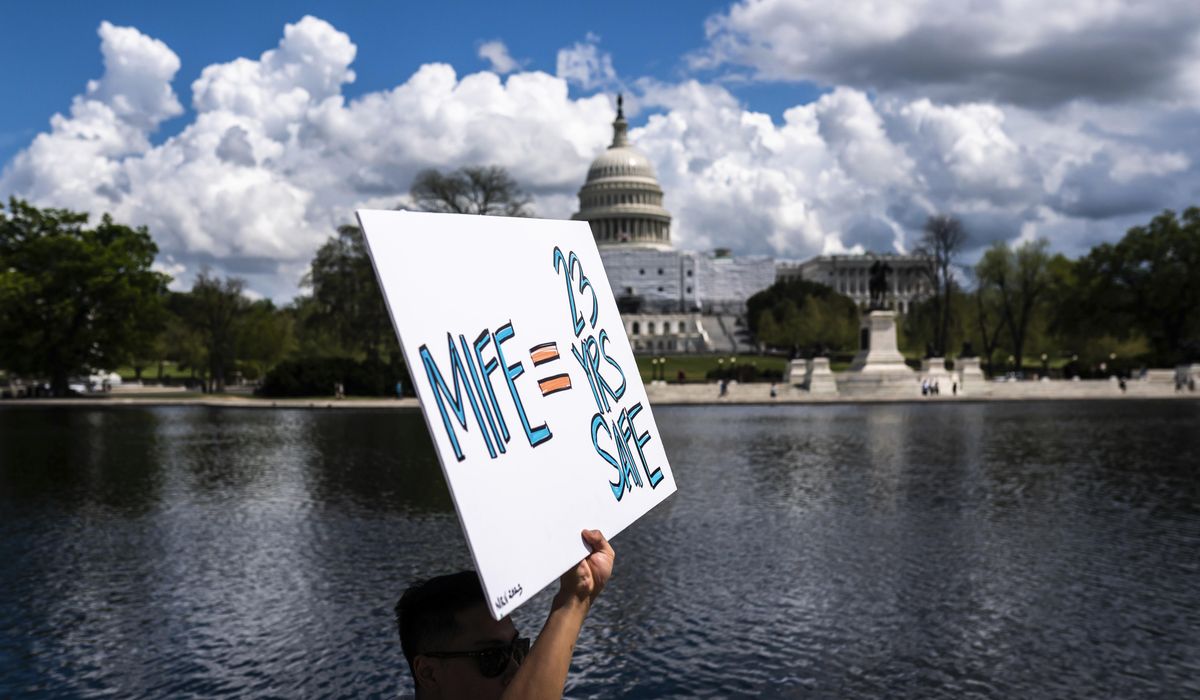


Nearly two-thirds of U.S. women are using abortion pills to end their pregnancies instead of surgical procedures, a stunning increase that comes despite red-state restrictions and a challenge to the drug’s safety before the Supreme Court.
Figures released Tuesday by the pro-choice Guttmacher Institute found that about 642,700 pregnancies recorded in the health care system were terminated in 2023 using the abortion pill process, representing 63% of all abortions — up from 53% in 2020.
That percentage has increased steadily since the Food and Drug Administration approved mifepristone for pregnancy termination in 2000, but the latest jump suggests that the Biden administration’s decision to relax restrictions has had an impact.
In December 2021, the Food and Drug Administration made permanent a pandemic-era rule eliminating the requirement for patients to pick up abortion pills in person and allowing them to be delivered via mail.
“Increased access to and use of medication abortion is likely one reason why the overall number of abortions in the formal health care system increased 10% nationally between 2020 and 2023,” the Guttmacher Institute said in its report.
The surge also comes despite concerns about the two-pill regimen’s safety. The Supreme Court is considering a 2022 lawsuit from pro-life doctors accusing the FDA of placing women at risk by rushing to approve mifepristone, then lowering the gestational age from 10 to seven weeks without proper study.
Oral arguments in Alliance for Hippocratic Medicine v. FDA are scheduled for March 26.
Abortion pills have also become more popular in the wake of the Supreme Court’s 2022 decision overturning Roe v. Wade, which prompted about two dozen states to tighten limits on abortion access.
Fifteen states now require a physician to prescribe the two-drug regimen, while five states — Arizona, Nebraska, North Carolina, South Carolina and Wisconsin — require the patient to meet with the doctor in person, according to Guttmacher.
In addition, Arizona and North Carolina prohibit mailing abortion pills to patients.
“Medication abortion has proven to be a game changer in expanding abortion care in the United States,” the institute said. “Unfortunately, legal attacks and restrictive policies continue to challenge access.”
Tessa Longbons Cox, senior research associate at the pro-life Charlotte Lozier Institute, called the latest figures “nothing short of a tragedy.”
“While Guttmacher’s report doesn’t count abortion drugs illegally mailed into pro-life states from other states with so-called ‘shield laws,’ other research suggests these account for a large share of mail-order abortions,” said Ms. Cox. “These numbers are unfortunately not surprising given abortion advocates post-Dobbs, including Guttmacher, have not only pushed unlimited abortion, for any reason, at any point in pregnancy, but supported the removal of safeguards on abortion drugs at the expense of women’s safety.”
Representing the pro-life doctors is the Alliance Defending Freedom, which said that the FDA “betrayed women and girls when it removed the necessary in-person doctor visits that protected women’s health and well-being.”
“The FDA’s own label for abortion drugs says that roughly one in 25 women who take them will end up in the emergency room,” ADF senior counsel Erin Hawley said in a March 15 statement. “Yet the government continues to defend its reckless actions that jeopardize women’s health and safety.”
The two-pill protocol begins with mifepristone, which blocks the hormone progesterone and stops fetal growth, followed by misoprostol, which induces “cramping and bleeding that empties your uterus,” said Planned Parenthood, a major abortion pill prescriber.
Guttmacher said the number of known facilities prescribing abortion pills via telemedicine and delivering the prescriptions via mail increased from 7% in 2020 to 31% in 2022.
“Medication abortion provided via telemedicine is as safe and effective as provision in a health care facility,” the institute said.
The data was taken from Guttmacher‘s Monthly Abortion Provision Study, which collects information from abortion clinics as well as online-only providers.
“These estimates do not include abortions obtained outside of the formal health care sector or any abortions — whether self-managed or provided by out-of-state clinicians — involving medication mailed to states with total abortion bans,” Guttmacher said.
No state has a total abortion ban. Every state includes an exception to save the life of the mother.
In addition, most states with tight abortion laws allow abortions for other reasons, such as to prevent serious risk to the women’s health; pregnancies result from rape or incest, or in cases where the baby is not expected to survive the pregnancy.
In 2001, just 6% of abortions were accomplished via abortion pills. By 2017, it was 39%, and in 2020, abortion pill procedures had surpassed the number of surgical abortions.
• Valerie Richardson can be reached at vrichardson@washingtontimes.com.
